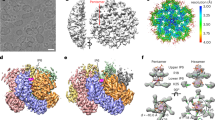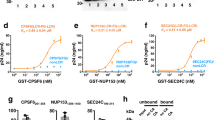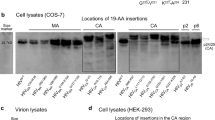Abstract
Immature HIV particles bud from infected cells after assembly at the cytoplasmic side of cellular membranes. This assembly is driven by interactions between Gag polyproteins. Mature particles, each containing a characteristic conical core, are later generated by proteolytic maturation of Gag in the virion. The C-terminal domain of the HIV-1 capsid protein (C-CA) has been shown to contain oligomerization determinants essential for particle assembly. Here we report the 1.7-Å-resolution crystal structure of C-CA in complex with a peptide capable of inhibiting immature- and mature-like particle assembly in vitro. The peptide inserts as an amphipathic α-helix into a conserved hydrophobic groove of C-CA, resulting in formation of a compact five-helix bundle with altered dimeric interactions. This structure thus reveals the details of an allosteric site in the HIV capsid protein that can be targeted for antiviral therapy.
This is a preview of subscription content, access via your institution
Access options
Subscribe to this journal
Receive 12 print issues and online access
$189.00 per year
only $15.75 per issue
Buy this article
- Purchase on Springer Link
- Instant access to full article PDF
Prices may be subject to local taxes which are calculated during checkout



Similar content being viewed by others
References
Scarlata, S. & Carter, C. Role of HIV-1 Gag domains in viral assembly. Biochim. Biophys. Acta 1614, 62–72 (2003).
Wiegers, K. et al. Sequential steps in human immunodeficiency virus particle maturation revealed by alterations of individual Gag polyprotein cleavage sites. J. Virol. 72, 2846–2854 (1998).
Accola, M.A., Hoglund, S. & Gottlinger, H.G. A putative alpha-helical structure which overlaps the capsid-p2 boundary in the human immunodeficiency virus type 1 Gag precursor is crucial for viral particle assembly. J. Virol. 72, 2072–2078 (1998).
Briggs, J.A. et al. The stoichiometry of Gag protein in HIV-1. Nat. Struct. Mol. Biol. 11, 672–675 (2004).
Berthet-Colominas, C. et al. Head-to-tail dimers and interdomain flexibility revealed by the crystal structure of HIV-1 capsid protein (p24) complexed with a monoclonal antibody Fab. EMBO J. 18, 1124–1136 (1999).
Gamble, T.R. et al. Crystal structure of human cyclophilin A bound to the amino-terminal domain of HIV-1 capsid. Cell 87, 1285–1294 (1996).
Gitti, R.K. et al. Structure of the amino-terminal core domain of the HIV-1 capsid protein. Science 273, 231–235 (1996).
Momany, C. et al. Crystal structure of dimeric HIV-1 capsid protein. Nat. Struct. Biol. 3, 763–770 (1996).
Tang, C., Ndassa, Y. & Summers, M.F. Structure of the N-terminal 283-residue fragment of the immature HIV-1 Gag polyprotein. Nat. Struct. Biol. 9, 537–543 (2002).
Gamble, T.R. et al. Structure of the carboxyl-terminal dimerization domain of the HIV-1 capsid protein. Science 278, 849–853 (1997).
Worthylake, D.K., Wang, H., Yoo, S., Sundquist, W.I. & Hill, C.P. Structures of the HIV-1 capsid protein dimerization domain at 2.6 A resolution. Acta Crystallogr. D Biol. Crystallogr. 55, 85–92 (1999).
Li, S., Hill, C.P., Sundquist, W.I. & Finch, J.T. Image reconstructions of helical assemblies of the HIV-1 CA protein. Nature 407, 409–413 (2000).
Briggs, J.A., Wilk, T., Welker, R., Krausslich, H.-G. & Fuller, S.D. Structural organization of authentic, mature HIV-1 virions and cores. EMBO J. 22, 1707–1715 (2003).
Nermut, M.V. et al. Further evidence for hexagonal organization of HIV gag protein in prebudding assemblies and immature virus-like particles. J. Struct. Biol. 123, 143–149 (1998).
Nermut, M.V. et al. Fullerene-like organization of HIV gag-protein shell in virus-like particles produced by recombinant baculovirus. Virology 198, 288–296 (1994).
Huseby, D., Barklis, R.L., Alfadhli, A. & Barklis, E. Assembly of human immunodeficiency virus precursor Gag proteins. J. Biol. Chem. 280, 17664–17670 (2005).
Ganser-Pornillos, B.K., von Schwedler, U.K., Stray, K.M., Aiken, C. & Sundquist, W.I. Assembly properties of the human immunodeficiency virus type 1 CA protein. J. Virol. 78, 2545–2552 (2004).
von Schwedler, U.K., Stray, K.M., Garrus, J.E. & Sundquist, W.I. Functional surfaces of the human immunodeficiency virus type 1 capsid protein. J. Virol. 77, 5439–5450 (2003).
Sticht, J. et al. A peptide inhibitor of HIV-1 assembly in vitro. Nat. Struct. Mol. Biol. 12, 671–677 (2005).
Bahadur, R.P., Chakrabarti, P., Rodier, F. & Janin, J. A dissection of specific and non-specific protein-protein interfaces. J. Mol. Biol. 336, 943–955 (2004).
Sarafianos, S.G., Das, K., Hughes, S.H. & Arnold, E. Taking aim at a moving target: designing drugs to inhibit drug-resistant HIV-1 reverse transcriptases. Curr. Opin. Struct. Biol. 14, 716–730 (2004).
Otwinowski, Z. & Minor, W. Processing of X-ray diffraction data collected in oscillation mode. Methods Enzymol. 276, 307–326 (1997).
Storoni, L.C., McCoy, A.J. & Read, R.J. Likelihood-enhanced fast rotation functions. Acta Crystallogr. D Biol. Crystallogr. 60, 432–438 (2004).
Brünger, A. & Rice, L. Crystallographic refinement by simulated annealing: methods and applications. Methods Enzymol. 277, 243–269 (1997).
Jones, T.A. & Kjeldgaard, M. Electron-density map interpretation. Methods Enzymol. 277, 173–208 (1997).
Collaborative Computational Project. Number 4. The CCP4 suite: programs for protein crystallography. Acta Crystallogr. D Biol. Crystallogr. 50, 760–763 (1994).
Lee, B.M. & Richards, F.M. The interpretation of protein structures: estimation of static accessibility. J. Mol. Biol. 55, 379–400 (1971).
Carson, M. Ribbons. Methods Enzymol. 277, 493–505 (1997).
Glaser, F. et al. ConSurf: identification of functional regions in proteins by surface-mapping of phylogenetic information. Bioinformatics 19, 163–164 (2003).
Acknowledgements
We thank H. Van Tilbeurgh for access to the robotized platform of the Yeast Structural Genomics Laboratory and J. Werner, P. Vachette and J. Janin for helpful discussions. This work was supported by the Agence Nationale pour la Recherche contre le SIDA, the Deutsche Forschungsgemeinschaft, the Centre National de la Recherche Scientifique, the Institut National de la Recherche Agronomique, the SESAME program of Région Ile-de-France and the French/German PROCOPE scientific exchange program.
Author information
Authors and Affiliations
Corresponding author
Ethics declarations
Competing interests
The authors declare no competing financial interests.
Supplementary information
Supplementary Table 1
Buried surfaces at dimer and C-CA/CAI interfaces. (PDF 12 kb)
Supplementary Table 2
Dimer contacts and C-CA/CAI interactions. (PDF 20 kb)
Rights and permissions
About this article
Cite this article
Ternois, F., Sticht, J., Duquerroy, S. et al. The HIV-1 capsid protein C-terminal domain in complex with a virus assembly inhibitor. Nat Struct Mol Biol 12, 678–682 (2005). https://doi.org/10.1038/nsmb967
Received:
Accepted:
Published:
Issue Date:
DOI: https://doi.org/10.1038/nsmb967
This article is cited by
-
Identification of 2-(4-N,N-Dimethylaminophenyl)-5-methyl-1-phenethyl-1H-benzimidazole targeting HIV-1 CA capsid protein and inhibiting HIV-1 replication in cellulo
BMC Pharmacology and Toxicology (2022)
-
Rotten to the core: antivirals targeting the HIV-1 capsid core
Retrovirology (2021)
-
In-solution enrichment identifies peptide inhibitors of protein–protein interactions
Nature Chemical Biology (2019)
-
Multiple Roles of HIV-1 Capsid during the Virus Replication Cycle
Virologica Sinica (2019)
-
Structure and mutagenesis reveal essential capsid protein interactions for KSHV replication
Nature (2018)



